( – promoted by buhdydharma )
This essay is sort of a prequel to two that I am scheduled to write for What’s for Dinner, posted at Dailykos.com (and here) Saturday evenings around 7:30 Eastern. Next Saturday I am writing rather long one about jellies (and related items) with lots of technical information and pictures of the process from start to finish. On 05 December I return to write about my favorite holiday goodies.
This got me to thinking that some of those goodies need background preparation before cooking them. Tonight we will discuss several key ingredients in some of my favorites, and some of the biology and natural history about them. Some things, like preparing nuts and persimmons, HAVE to be done in advance for various reasons, and some can be done in advance to ease the workload during the busy holiday season.
Nuts
Nuts of one kind or another are a central part of holiday cooking for several reasons, not the least important of which is that most of them are in their prime in late fall and early winter. Most folks just buy their nuts at the store, but for a forager like me, that is sort of empty. Besides, two of the best cooking nuts are either not available at all in stores or are extremely expensive. I shall describe them in a little while.
Since most people buy nuts from the store, most people are not aware that most nuts, right off of the tree, are not really fit to eat. Depending on the nut, a shorter or longer period of curing is necessary for them to be ready. The curing period depends mostly on the thickness of the shell, but the surface area of the nutmeat is also a factor. Nuts in the store are already cured, sometimes for too long, since they go rancid relatively quickly if not protected from oxygen after the initial cure.
The best way to protect nuts from oxygen is to leave them in the shell. Obviously, this is not feasible if one buys preshelled nuts. When buying preshelled nuts, be sure to look at the expiration date get fresh ones. Buy only what you will use in the next month or so, and protect unused portions by wrapping in an oxygen barrier (polyvinylidine cling wrap, Saran or Sam’s Choice Premium Wrap) securely and then putting them in freezer bags and storing them in the freezer. Freezer bags are moisture barriers, but polyethylene film is NOT an oxygen barrier and thus offer no protection from rancidity, which is the result of oxygen reacting with the highly unsaturated fats in most nuts. (Brazil nuts are an exception, containing mostly saturated fat, but they will go rancid given enough time).
My two favorite nuts are hickory nuts and black walnuts. I have never seen hickory nuts at any store, shelled or otherwise. Black walnuts are to be had, but they are pricey. Sam’s Club carries, or used to carry, them in larger bags that were more reasonable, but I always get my own. I will have to limit the discussion to walnuts this year, because in the Bluegrass there has been an absolute failure of the entire hickory nut crop, regardless of species of tree. By the way, all hickory nuts are good to eat if they are not bitter; there are no toxic species. The pecan, considered by many to be the finest nut, is a species of hickory.
Hickories and walnuts are related, both being in the family Juglandaceae. Walnuts are from the genus Juglans, and hickories from the genus Carya. The main difference, other than flavor, is that the husks in the hickory tribe split into four ridges that typically fall off of the nut in sections, leaving a clean nut, whilst walnuts have a single husk that does not fall off of the nut but rather has to be removed. Black walnuts have a very thick husk that has to be removed before the nut can cure. Hickories often cure on the ground under the tree since the husk naturally releases the nut.
Here is a picture of leaves and fruits. The tree can grow very large, up to 80 feet or more. They are hard to confuse with anything else. The black walnut is Juglans nigra, whilst the common, grocery story walnut is Juglans regia. You are welcome to my share of Juglans regia as I find them to have a very poor taste and smell, but of course I have been spoilt by black walnuts.
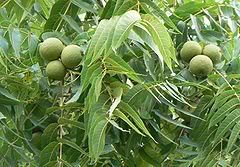
Black walnut leaves and fruit in husk
The nice thing about black walnuts is that they hardly ever fail to produce a crop, and they fall off of the tree so all you have to do is pick them up as far as collecting them goes. Last week I went to a spot that I like and picked up four boxes (actually cases of 6, 1.5 liter liquor bottles that the liquor store gives away) in less than 45 minutes. Here is one boxfull:
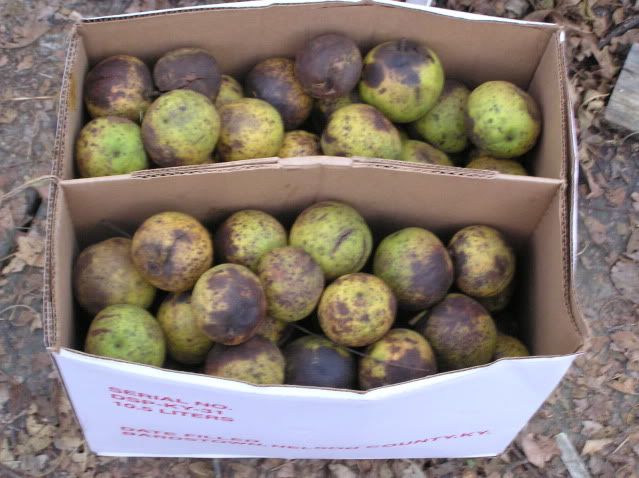
Now comes the work. The husks have to be removed. I have tried all sorts of methods, and the one that seems to work best is the one that I will show you. Some folks throw them in the driveway and drive over them to remove the husk, but then you have to pick them up again. Others grind them under a bootheel whilst collecting them, but then the nut is embedded in the ground. My method is fast and easy.
Take a board and use an expansion bit or hole saw and make a hole in it just barely larger than the nuts within the husk (walnuts vary in size from tree to tree, so different holes are sometimes necessary). Then put a nut on the hole (on its side, you can tell by the stem on the husk) and drive it through with a hammer. The husk stays on the board, whist the nut falls through the hole. Actually a little bit of husk, the part over the hole, stays on the nut, but with a little practice you will soon be able to catch the nut and remove the little bit of husk before dropping it into your container of dehusked nuts). Here are pictures of the process:
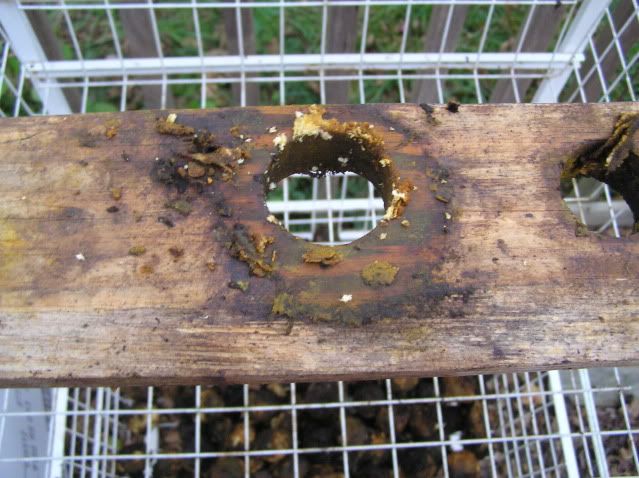
Husking board. Note the dark stain around the hole.
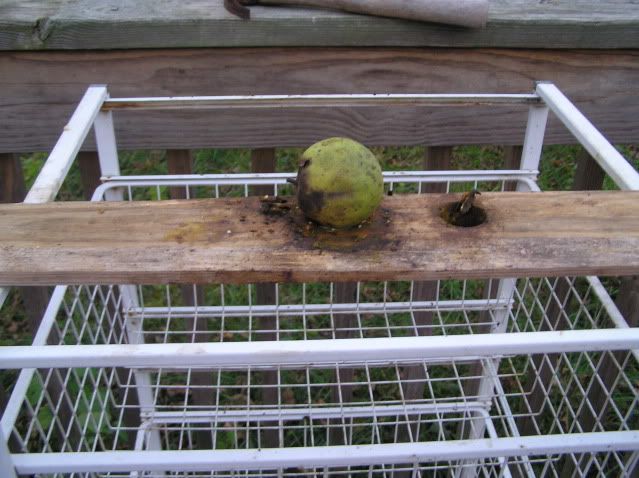
Walnut on husking board
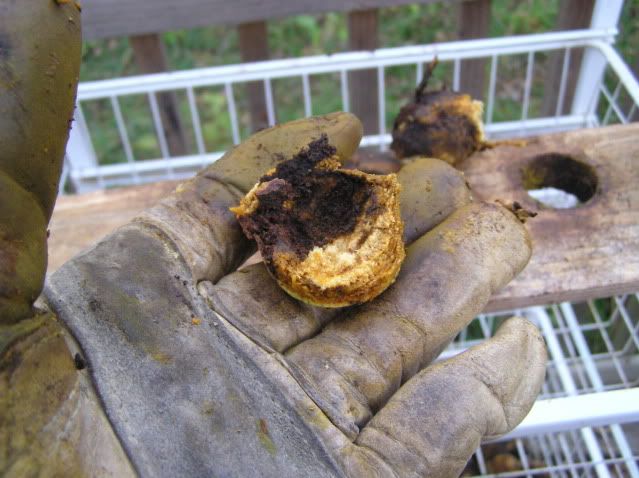
Walnut after passing through hole
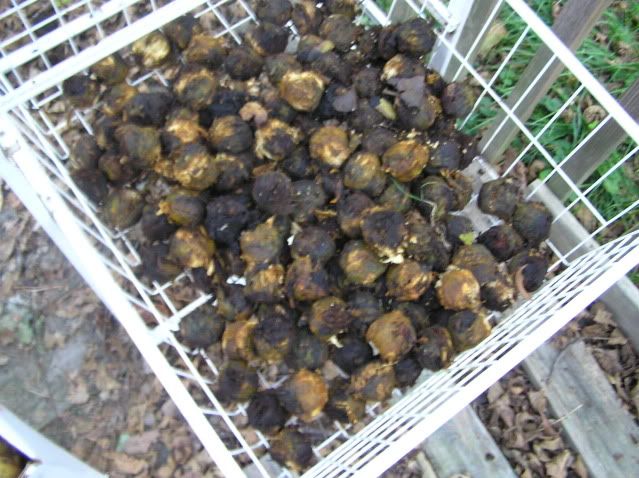
Batch after dehusking
Before we continue, note that I am wearing a heavy leather glove. That is to protect the latex glove from the rough walnut shell from tearing it. Black walnut husks stain everything they touch an indelible dark brown. Be sure and use latex, since a vinyl glove allowed the stain to penetrate. If you have an allergy to latex, get someone to help husk them. Even picking them up can stain fingers, but the leather glove is sufficient for that task since you are handling mostly intact husks, not ones mangled by the dehusking process. Here is a picture of my left hand, taken today, Sunday. I handled the dehusked walnuts using a vinyl glove for only one box when I realized that vinyl would not protect from staining. The staining happened last Tuesday and is still quite noticeable. As a matter of fact, walnut hull juice was used as a brown dye by the pioneers. Obviously I was using mainly my thumb, index, and middle finger since the ring and little fingers are not stained.
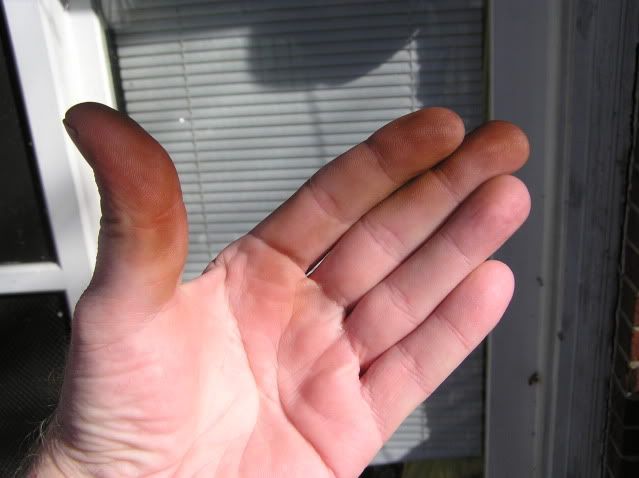
Walnut stained fingers
This is another argument against the driveway method or the bootheel method for dehusking walnuts, as you are apt to track this staining material into your house. Once the walnuts are washed and dry thoroughly, they no longer stain.
After dehusking, there are still remnants of husk and some fibrous material clinging to the nuts, to they need a washing with a garden hose set to a strong jet of water. Be sure to do this where splashes will not stain anything that you do not want stained. It is also a good idea to wear old clothes.

After washing, allow the nuts to drip dry and store them in the dry for three or four weeks. After that time they will be cured. You can tell when they are cured by cracking one every couple of days and tasting the nutmeat. When they are fully cured the nutmeat develops a very aromatic scent and loses its watery texture. The skin on the nutmeat also darkens considerably. I can not tell you exactly how uncured and cured nuts are different, but it will be obvious to you if you taste one every few days.
After they are cured, the chore is to crack them. The most commonly utilized method is just to take a heavy hammer to them, but a heavy vise works well too. If using a hammer, turn the walnut onto its narrow side and hit it there whilst holding the flat sides with the opposite thumb and forefinger to the hammer hand. Light gloves will keep the rough nut from scraping your fingers. With a little practice, you will find that more often than not you can crack the nut such that it breaks into quarters, making extraction of the nutmeat easier. Do not over hammer them or you will just crush up the nutmeat and embed bits of shell in it. You will have to rely on a nutpick quite a little.
I did not show pictures of this process because my nuts are not cured yet, and they are too precious to waste. I suspect that you will agree with me after you cook with them, or even eat them as is. In the 05 December installment of What’s for Dinner? I shall share some recipes.
I know this sounds like a lot of work, and it is. However, other than good hickory nuts I know of no better tasting nut, wild or domestic. By the way, if you have hickory nuts in your locale, none of the husking process is needed. Just let the nuts cure for a couple of weeks, crack them, and pick them out with a nutpick. The tree that I visited last year had relatively small nuts, but the shells were so thin that I could easily crack them with a pair of Channelok pliers. Because of the thin shells, the nutmeats were as big as much larger nuts with thicker shells. Hickories vary much more from tree to tree than walnuts both is size, taste, and shell thickness, so shop around until your find your favorite tree.
Since this IS Pique the Geek, there are some interesting biological and chemical properties in Juglans niger. In addition to its staining properties, black walnut trees contain a defensive compound called juglone. Juglone is also partially responsible for the staining properties, but the husks also develop high concentrations of very dark polyphenols as they age.

Juglone
Juglone is toxic to many different plants, and it is hard to grow many things near a walnut tree. This is not just in the nuts, but in the leaves as well. Tomatoes are severely affected, as are several other desirable plants. It is hard to grow grass under a walnut tree, but a lot of that is probably due to the dense shade that they provide. Walnut hull juice is used by the old folks in my ancestral home area for ringworm and athlete’s foot and for mange on dogs. I am told that half a bushel of walnut hulls, put into a burlap bag and beaten with a club until they exude juice in quantity can be used to stun fish in ponds, but do not tell anyone that I said so.
Persimmons
The wild persimmon is the most neglected and reviled fruit in North America, but I love them. They are also contain the highest level of natural sugar of any native fruit, and rival dates and figs in carbohydrate. They have twice the carbohydrate than typical orchard apples have, and 32% more Vitamin C and 55% more potassium than oranges. They have almost as much iron as spinach, more phosphorous than any common fruit except for tomatoes.
So why is this nutritious (and delicious) fruit overlooked so often? There are really two answers. The first is that most people are familiar with them only when they are underripe, and the extremely high tannin content makes them so astringent that eating them is torture, even if they look ripe. The other reason is that they do not ripen off the tree, and a ripe persimmon is so soft and mushy that it can not be shipped. Think of a tomato that is going rotten. In comparison, a ripe persimmon makes the tomato seem firm. The only way to enjoy persimmons is to get them yourself and handle them very gently.
There is a misconception concerning persimmons getting ripe. The tale is that they have to be exposed to frost before they will ripen. This is absolutely untrue. The further south one goes in their range, the earlier they ripen. Incidentally, the further south ones goes the later the average date for the first frost. It has frosted several times here already, and a couple of the persimmons described below with difficult to remove calyxes were very astringent. It is time on the tree that ripens persimmons, and frost is not involved directly. It certainly does not have to do with cell disruption, because the sugar content of persimmons is so high that they have to get really cold to freeze. You may also read about gastric problems with persimmons. This is mainly due to the tannin content in some varieties of Asian persimmons. If you eat only “nonpuckery” American persimmons, you have no danger. The only health consideration, other than the high vitamin and mineral content that are positive, is that diabetics should consume them very lightly due to the high sugar content.
Botanically, the persimmon is a member of the ebony family, and its Latin name is Diospyros virginiana. It is quite an attractive tree, with glossy, dark green foliage and a distinctive, checkerboard bark. One group of people who do appreciate the persimmon are golfers with high end clubs, because the finest wooden drivers are made with heads of persimmon wood. After all, it is an ebony.
The native persimmon bears little resemblance to the Asian varieties, being much smaller than most of them and softer when ripe. The big persimmons that you see at the store are the Asian kind. They are OK, but I am with them like I am with English walnuts: you can have my share.
Here is a picture of the tree whence I got the persimmons yesterday. It belongs to a very nice older black man a couple of miles from me. He graciously gave me permission to “get as many as I want.” I shall take him some goodies later this year.
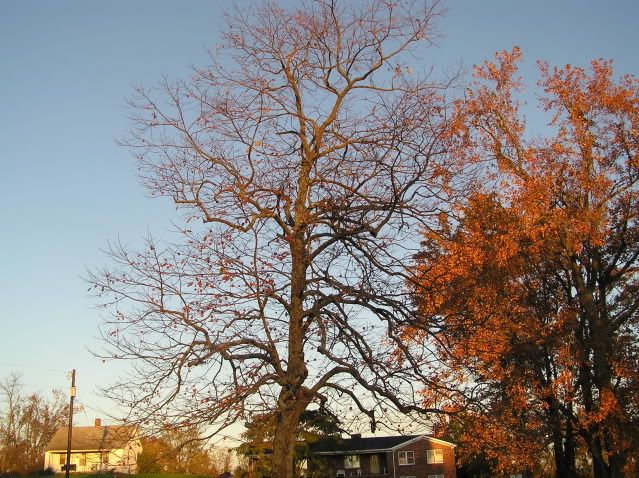
Persimmon tree
The fruit falls easily from the tree when it ripe, but on some trees some are still hanging late in the season. If the wind does not knock them off, as they dry out they tighten up on the tree. I do not have the luxury of this and must get them as soon as they are ripe, because persimmons are sort of scarce in this location and I have to compete with the raccoons and opossums. The best way to collect them is to take a plastic sheet under a limb and shake the limb (not too hard, because you want the unripe ones to stay on the limb, and persimmons do not ripen all at once). Then gently pick them up and place into a clean pail. You are better off to use several pails with shallow layers, as a ripe persimmon crushes easily, and the ones on the bottom of a full pail will liquefy from the weight of the ones on top.
The calyx (the four lobed, leathery piece where the fruit joins the tree) is easily removed from ripe persimmons, and often the fruit without the calyx will fall onto the sheeting. When you get ready to clean them, be very wary of fruits that have calyxes that are hard to remove, because they may not be ripe. If in doubt, taste a little of a fruit to make sure that it is not astringent. One bad persimmon can spoil a whole batch of food.
Here is a persimmon with the calyx on. Obviously it has to be removed before you can process it further. In addition, there is a tiny woody projection from the opposite end on the fruit that needs to be removed as well.
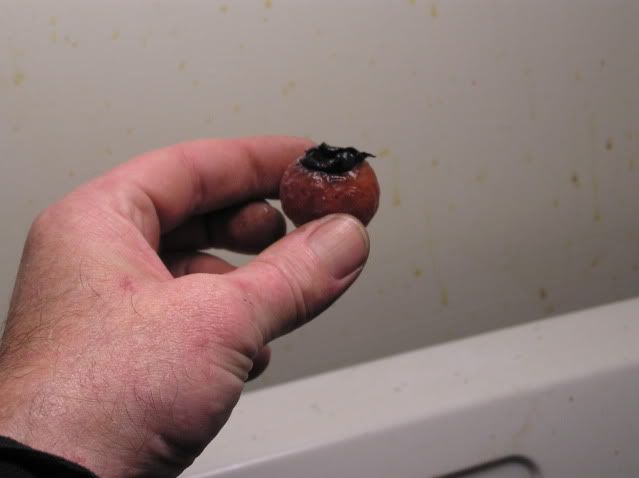
The bark is distinctive and can help you identify the tree before it sets fruit.

Persimmon tree bark
The fruit is attached directly to the tree, with no any stem of which to speak.
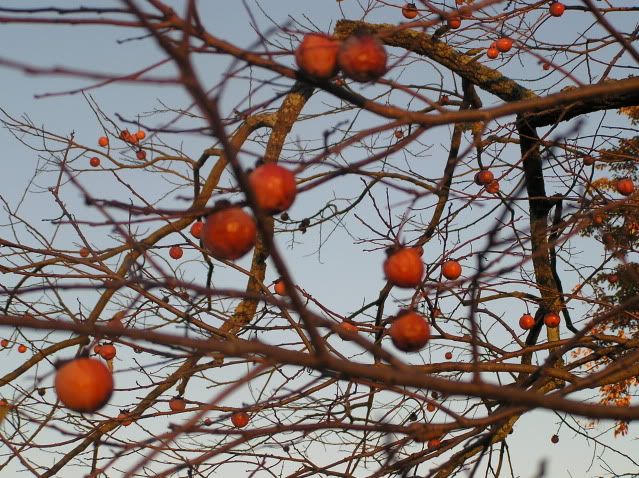
Persimmons on tree
Euell Gibbons liked dried persimmons, but I do not care for them. The ones here are too seedy. Persimmons vary tremendously from tree to tree, and some trees produce fruit that is essentially seedless. Those are the ones to dry. If you live where there are lots of trees, be sure and shop around to find the best trees.
Here was my haul from yesterday. There are lots left on the tree, and I will visit it again a number of times as they ripen.
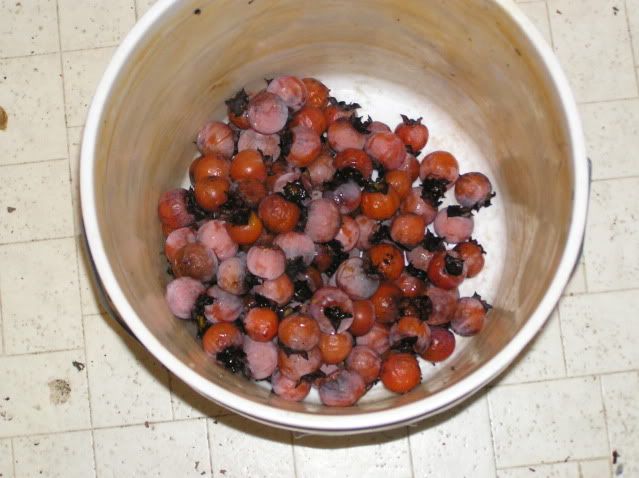
Bucket of persimmons
If I had gotten very many more, I would have used another pail for them because of the crushing that I mentioned a while ago. By the way, rough roads are bad for persimmons in a pail, so watch for that as well.
I got them home and removed the calyxes and the little stem and put them in a bowl for rinsing. You really can not wash a persimmon because they are so soft, so a gentle rinse is the best that you can do. Be as clean as possible when collecting them to minimize any trash amongst them. Here they are after I rinsed them. I run them through a food mill to remove the seeds and skins, because I want the pulp for holiday breads.
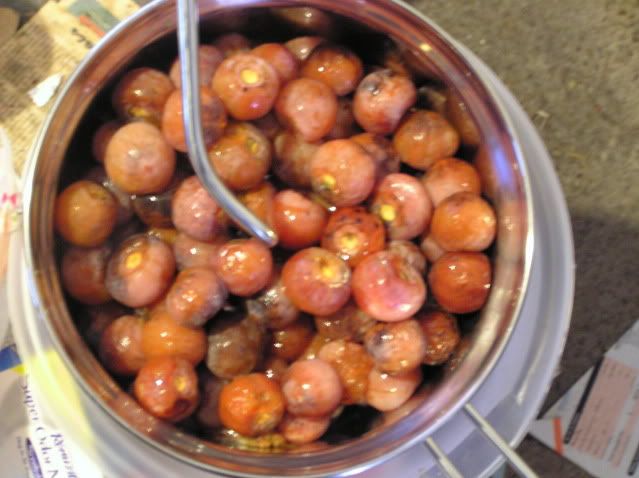
Rinsed persimmons. Note that they are in my Foley food mill.
Now it is just a matter of cranking the mill until as much pulp as possible is extracted. I should have put them in the mill in small batches to make it easier to remove the seeds, since the efficiency of the mill decreases rapidly when a layer of seeds are on the bottom. After the milling was done, I had about four cups of pulp left.
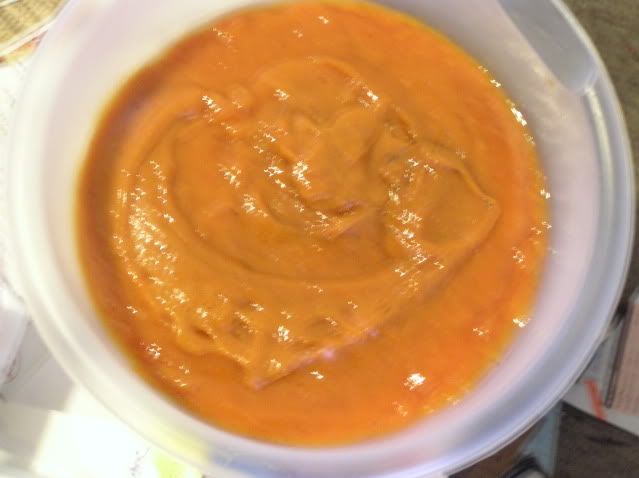
Raw pulp
Judging from the color, this has a lot of carotene, provitimin A, in it, like sweet potatoes and winter squash. The last step is to can the pulp. I packed it raw into two, one pint Mason jars, attached the lids, and processed it in a boiling water bath for 45 minutes. The sugar content of persimmons is so high that pressure processing is not needed. Here is what it looked like after processing.
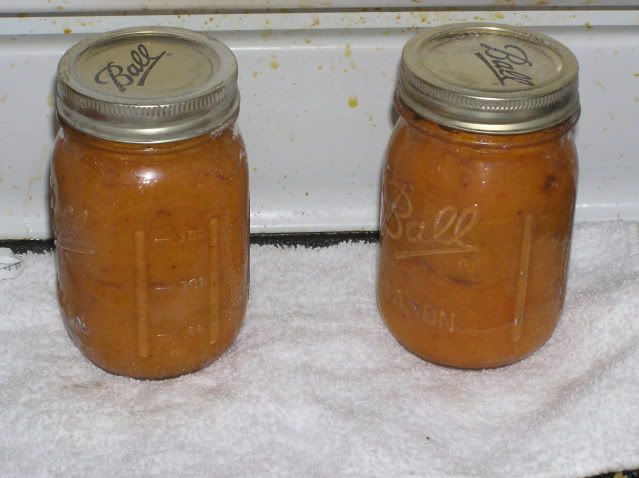
Processed persimmon pulp
Like for the walnuts, I shall share recipes in the December 05 What’s for Dinner?
post.
Those are examples of things that I had to do early because of the cure time for the nuts and the competition with the critters for the persimmons.
There are some things that I choose to do beforehand because it is just as easy to do it early and I can focus on cooking the final products rather than preparing ingredients for them. One such activity is candying fruit for the very tasty treat called a “Lizzy”. These are highly spiced, soft cookies made with candied maraschino cherries (this is the only thing that I use maraschino cherries for, because they are really not very good. However, Lizzies are no good without candied ones), candied pineapple, raisins, and pecans. My mum mastered the recipe and I am the only one left in the family who remembers how to make them. I shall share the recipe with you on 05 December. I find commercially candied fruit to be pretty awful, so I always make my own.
To candy the cherries, I got two, 28 ounce jars of them at Kroger (make sure and get the stemless kind) and emptied them into a large vessel. Like all acid foods, use glass, stainless steel, or coated aluminum. I added enough water to cover them about an inch and then two cups of sugar. I simmered them for about an hour and cut the heat, leaving them to soak at room temperature (covered) overnight. The next day I added another cup of sugar and simmered them for another hour and checked them. They were almost ready, and after another 30 minutes were done.
I drained off the syrup into a stainless steel bowl and allowed the cherries to drain for a while. Then I placed them on a cookie sheet covered with waxed paper to dry. They need not to touch each other or they stick together. A pair of chopsticks is the ideal tool for handling them one at a time. It is better to have them a little warm because they get really sticky as they cool and are hard to handle. Let them dry for a couple of days, bag them in a freezer bag, and refrigerate until use. They will keep for months in the refrigerator.
I did the same thing with the pineapple. The “tidbit” size is just right for Lizzies. For candied pineapple, always get the kind in heavy syrup, since they are partially candied already, so it saves you both time and sugar. Since pineapple is light in color, throw in a couple of 500 mg tablets of Vitamin C to keep them from darkening. Candied fruit is done when it becomes translucent rather than transparent. I have some pictures, but it is kind of hard to see.
I took the syrup that I drained off each batch of the fruit and brought it back to the boil. Then I poured it back into the jars that the cherries were packed (after I sterilized them and the lids) and sealed them with the original lids. The result was a beautiful jar of intensely red maraschino cherry syrup and another of golden pineapple syrup. I normally do not recommend using anything other than standard Mason jars and new lids, but fruit syrup has so much sugar and acid in it that the worst thing that could happen with a bad seal is that it would mold after a few months. Besides both lids sealed as I heard the unmistakable “ding” when they did. I gave them to my dear neighbors across the street because they eat much more sweets than I do. I would be a shame to waste the sugar that went into it.
Here are pictures of the cherries and pineapple on the cookie sheets. You can see that the fruit has lost its opacity and has become translucent. That is how you can tell when it is done. It turns out that the long, room temperature soak after a relatively brief simmer is more efficient at candying fruit, because it takes time for the sugar to penetrate the cell structures. It also avoids carmelization and darkening, making for a fresher tasting product. The old recipes that call for boiling to the soft ball stage are just too hot. It is time, not temperature, that candies the fruit.
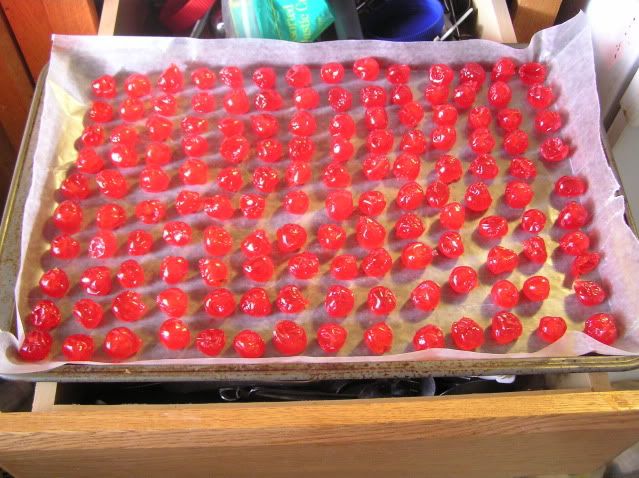
Candied cherries on cookie sheet
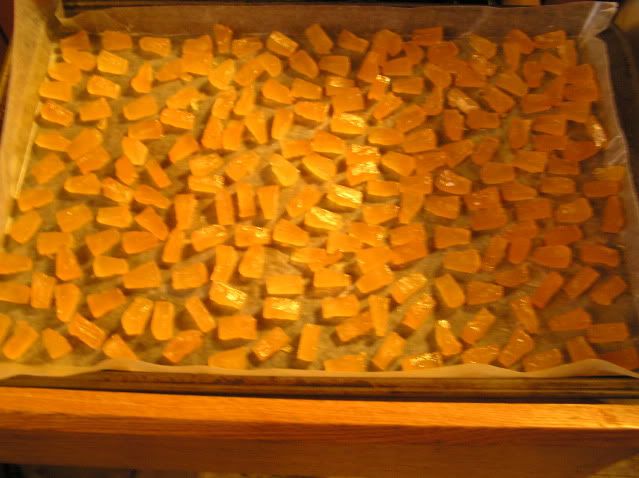
Candied pineapple on cookie sheet
I just went across the street and had Helen get the fruit syrup out so I could take a picture. The jars are a little foggy because they were in her and Elmer’s refrigerator. They got into the cherry syrup today for breakfast with pancakes.

Remember, next Saturday night at 7:30 Eastern I guest host What’s for Dinner? and it is about the science and considerable art of jellies and related materials, and I will be back Sunday with more Pique the Geek, topic to be determined. Any suggestion is welcome.
Well, you have done it again. You have wasted another perfectly good batch of electrons reading this syrupy stuff. And even though Dr. Isadore Rosenfeld becomes accurate and eloquent when he reads me say it, I always learn much more than I could possibly hope to teach writing this series. Please keep comments, corrections, questions, and other information coming. Remember, in this series, no science or technology issue is off topic, regardless of the content of the essay at hand.
Warmest regards,
Doc
Crossposted at Dailykos.com

31 comments
Skip to comment form
Author
for holiday treats? Time draws nigh.
Warmest regards,
Doc
Leared more than I thought I would as usual.
Got to go walk the dog.
I think you would make a good blog owner Doc.
i have a black walnut tree & after years of died fingers & yucky nuts i gave up. i had NO idea they had to cure! i will go down the field tomorrow & see if there’s a crop this year.
i’m in awe of your sheller idea for these beastly nutz!
maybe now me & the walnuts will have a better relationship.
love persimmons!

i make persimmon bread (euell gibbons recipe) each year & freeze them. i hadn’t ever thought about canning the pulp before. brilliant!
i’m waiting anxiously for the 05 Dec WFD to get your recipes.
my largest best persimmon tree fell down this year
it had been untended for a decade & was overcome by weighty vines. there are some smaller ones nearby, but O how i cried when i saw it down.
what about candying bing cherries? can you?
will they taste as good?
are there any other fruits i could candy.
my mom’s fruitcake recipe would really be fabulous with these. & mrD dislikes citron so i usually add extra cherries, pineapple, raisins & currants. a larger variety of fruit would be beneficial i think.
…Debbie is finishing up her presentation for Tuesday, on Green Halloween.
Author
is a true honor. Thanks, Budhy!
Warmest regards,
Doc
…. this is really interesting and you have great pictures to go with it.
I’ve been LOVING the “Things We Eat: Food Preservation” series and look forward to the next installment – if there is one. Perhaps one on smokehouses or curing of meats or whatever yer heart desires, Doc.
As this is my very first comment on DocuD, I’ll take the opportunity to say “HI!” to everyone.
Celtic Merlin
(Geeky) Carlinist
about saffron? I ask b/c it’s a local specialty (along with black walnuts). What saffron I still have, I bought from a Mennonite family farm out near Ephrata, PA…and considering that a local specialty is Bot Boi (“pot pie” in English, but made with noodles — kind of like a stew rather than the more familiar pot pie made in a crust) — well, I know that saffron crocuses love our local weather: rainy during fall, winter, spring; then hot & sunny in the summer. (This year will probably be bad for local saffron, lol: cool & rainy, it was.)
I just keep imagining all these Amish & Mennonite kids sitting around a kitchen table, extracting the saffron threads with tweezers.
That can’t be right…can it?
I have a black walnut tree in my front yard. It is a race between the hominids and the tree rats to get the nuts. We have lots of giant oak and hickory trees, so the food base is great for the little grey ones and we have lots of them.
I have never seen the technique of using a piece of steel with a hole in it. That is just too cool. I gotta make one of those. I usually just put the nuts up to dry and when the husk is black and brittle it shells off easily. You are right about the brown stain. Get it on something and it is about as permanent as a Sharpie. On your hands you just have to wait for the skin cells to naturally shed and slough off over time ’cause it dang sure does not wash off.
Got a black walnut horror story for you. I saw this in the weekly newspaper in Johnson County, TN several years ago. Seems this fellow had a nice stand of black walnut trees in his yard near the road. He came home one day to find all of them cut down, and the logs cut into short lengths. The utility crew had cut down all the trees and then rendered the logs into short enough pieces they could be picked up and tossed into a truck. They were not even long enough to salvage and make dulcimer or guitar fretboards. The paper had a front page photo of the tree vandalism. The utility company was completely unapologetic. They defended their not notifying the property owner so he could cut down the trees and salvage thousands of dollars of precious black walnut wood by saying they did not have time to fool with notifying everyone they were going to trim trees. He got a lawyer. As I recall there were about fifteen trees worth approximately $25,000 each, give or take a few thousand. I never found out what the outcome of that was.